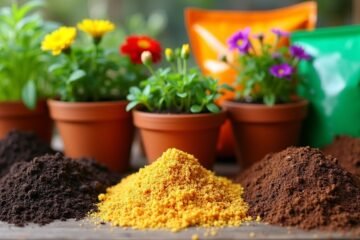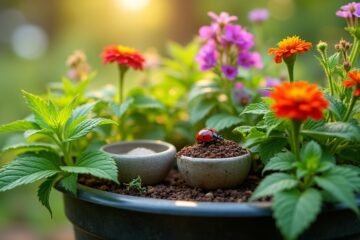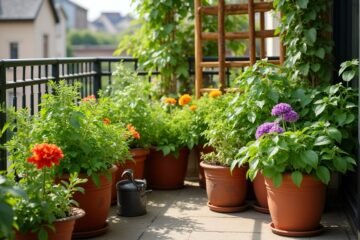Nurturing your potted herbs is like a delightful dance! Start with a light, breathable potting mix—think organic compost, perlite, and peat moss—to give those roots room to wiggle. Keep an eye on watering; not too soggy and not too thirsty! Sunlight is your friend, with most herbs craving six to eight hours of it daily. A sprinkle of organic fertilizer every month keeps them happy. Intrigued? Stick around to uncover the secrets of pruning and pest control!
Choosing the Right Potting Mix
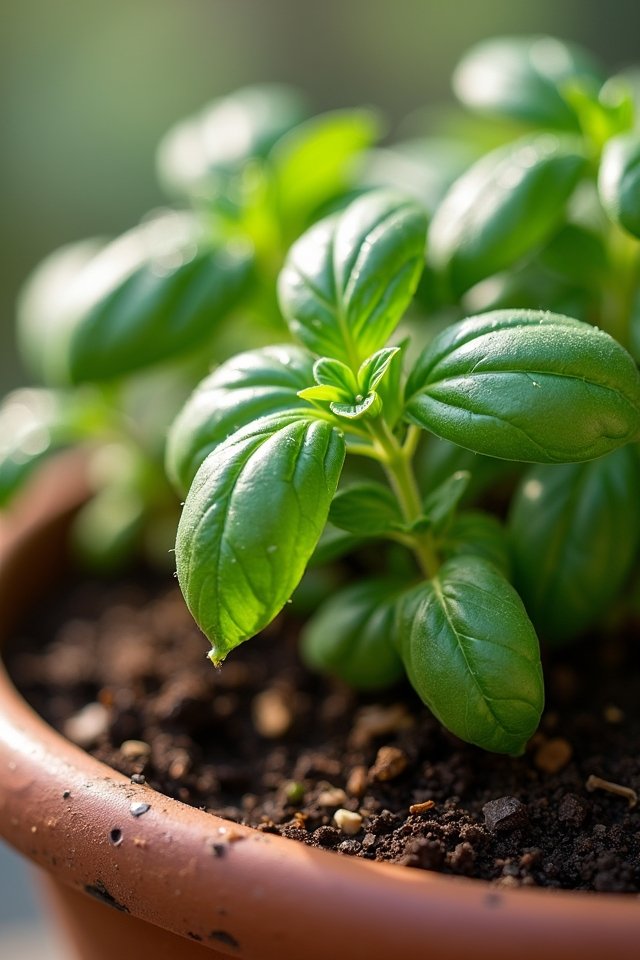
When you’re ready to plunge into the wonderful world of herbs, choosing the right potting mix is like picking the perfect shoes for a dance—it’s essential for a successful performance! For herb potting, you need a blend that encourages growth while ensuring good soil drainage. Imagine a mix of organic compost, perlite, and peat moss, like a luxurious gourmet meal for your herbs! This combination allows roots to breathe while preventing soggy soy sauce from drowning them. You want your herbs to thrive, not sink! So, go for a lightweight, well-aerated mix, ensuring each pot’s a cozy home. Trust me, your basil and thyme will thank you, bursting forth in vibrant greens, enthusiastic to delight your taste buds!
Proper Watering Techniques
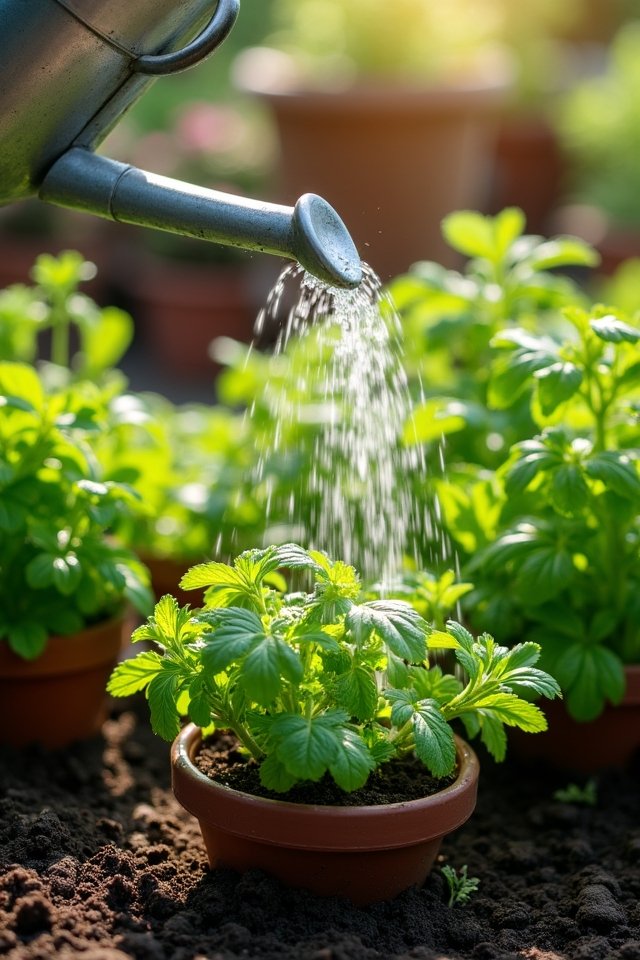
Watering your potted herbs properly is like playing a delicate symphony—too much or too little can throw everything out of tune! You want your herbs thriving, not drowning. Here’s how to hit the right notes:
- Check soil moisture regularly—feel it, don’t guess!
- Employ effective drainage methods to avoid soggy roots.
- Adjust your watering based on humidity levels—don’t let them get too cozy or too parched!
- Water at the base for deeper absorption.
Ensuring Adequate Sunlight
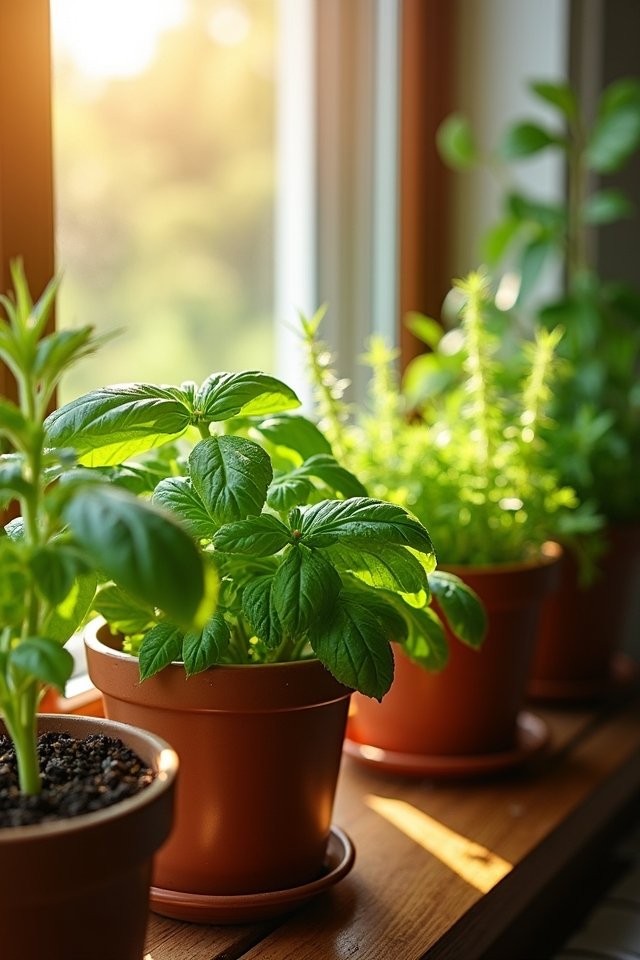
Though your potted herbs might not break into song, they sure thrive when bathed in the right glow of sunlight! Think of sunlight as the rockstar of their growth journey—everyone needs a little spotlight! Each herb has unique sunlight requirements; for instance, basil loves full sun, while mint prefers partial shade. You’ll want to make certain they get about six to eight hours of light exposure daily. Consider placing your herbs by a bright window or outside on a sunny patio. And hey, don’t forget to rotate the pots every now and then, so they soak up an even tan! Who knew your herbs craved a sunbathing session? Keep that sun shining, and watch them flourish! 🌱
Fertilizing Your Herbs
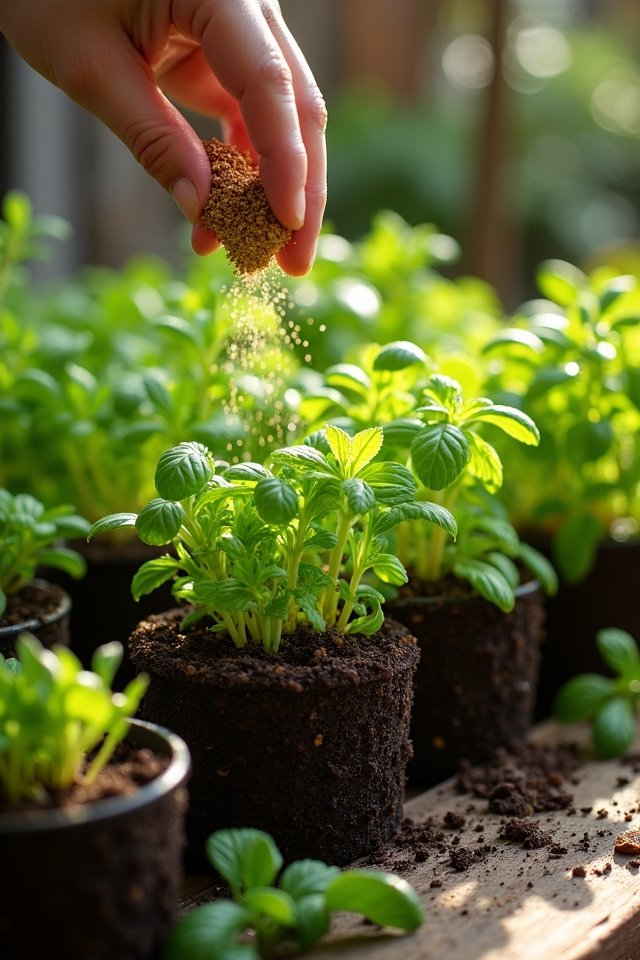
Just as a chef wouldn’t dream of concocting a delicious dish without seasoning, your herbs crave the right kind of nourishment to shine their brightest! Feed them well with organic fertilizers packed with essential herb nutrients. Think of it as a delightful herbal spa day!
- Use compost to boost soil health naturally.
- Apply fish emulsion for a nitrogen-rich treat.
- Try seaweed extract to enhance root growth.
- Choose slow-release granules for long-lasting benefits.
Give your herbs a little TLC regularly, every four to six weeks, and watch them flourish. They’ll reward you with vibrant flavors and aromas, elevating your culinary creations to new heights. So, let’s get those herbs pampered and ready for their starring role!
Pruning for Healthy Growth
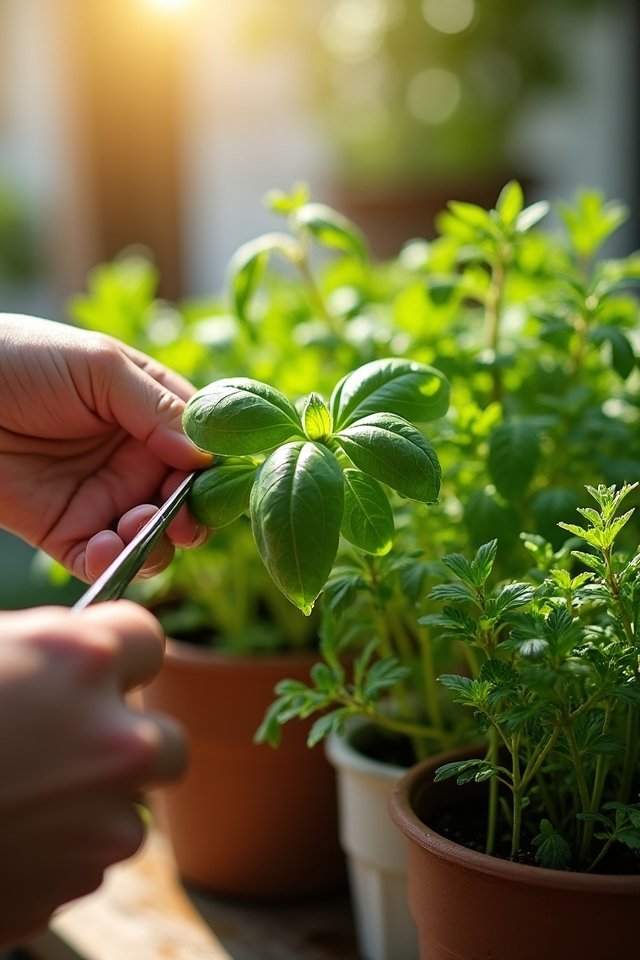
Once your herbs are well-fed, it’s time to give them a little haircut! Pruning’s not just a snip-snip; it’s a fantastically fun way to boost growth stimulation. Use clever pruning techniques, like cutting just above a leaf node, to encourage your plants to sprout new branches and become bushier. Think of it as encouraging a dance party among your herbs, where the more you trim, the more they groove! Regularly trimming helps prevent overcrowding and makes room for air to flow, keeping your herbs happy and healthy. Remember, don’t be shy! Welcome the snip and witness the transformation. With every cut, you’re not only shaping your herbs but also igniting their potential to flourish! Who knew gardening could be so exhilarating?
Pest and Disease Management
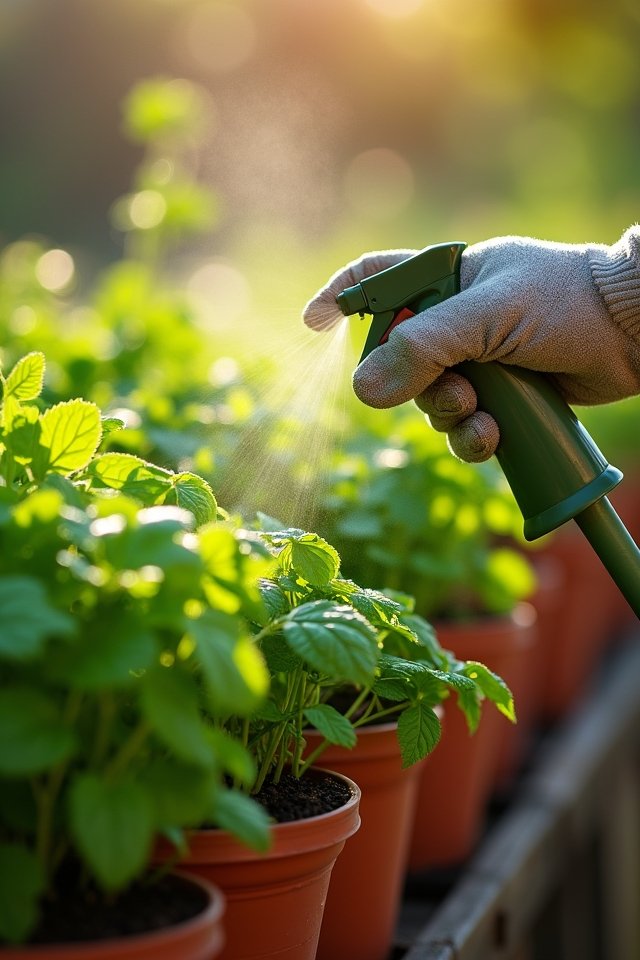
While growing your potted herbs can be a delightful journey, pest and disease management is essential to guarantee every leaf shines with health! You don’t want pesky bugs crashing your herb party, right? Here’s how to tackle it:
- Engage in regular pest identification to spot issues early.
- Use organic treatments like neem oil or insecticidal soap to combat invaders.
- Keep your herbs healthy with proper watering and light—strong plants resist pests better!
- Rotate your herbs periodically to disrupt harmful pest cycles.
When you notice those cheeky critters, act fast! Don’t let those aphids and spider mites spoil your culinary dreams. Remember, a thriving herb garden isn’t just fresh; it’s your colorful culinary canvas waiting to be painted with flavor!
Frequently Asked Questions
Can I Grow Multiple Herbs in One Pot?
Absolutely, you can grow multiple herbs in one pot! Just think of it like a delightful herb party! Choose compatible herbs like basil, parsley, and chives, avoiding those that might clash, like mint, which can be a bit too bossy. Make sure your pot’s size is generous enough—about 12 inches deep—so everyone’s roots can stretch! With the right mix, your pot’ll become a fragrant oasis. Ready to create your herb haven? Let’s dig in!
How Often Should I Repot My Herbs?
You should repot your herbs every 1-2 years—like giving them a fresh, cozy apartment! Check for roots peeking out, which signals it’s time for a change. If your herb potting looks cramped, they’re likely craving more space. Just remember, regular repotting keeps your herbs happy and healthy, like a spa day for them! So, keep an eye on those growing roots, and let your herbs thrive like they’re on a little vacation!
What Temperature Is Ideal for Indoor Herbs?
When it comes to keeping your herbs thriving, you’ve gotta know the temperature game! Most indoor herbs prefer a cozy 65 to 75°F, almost like a warm hug. Think about it: a comfy indoor climate keeps them happy and growing strong! If it’s too chilly, they’ll sulk and slow down! So, crank up the heat, but watch out for drafts! Your herbs will thank you with vibrant leaves and bold flavors! Isn’t that a win-win?
Can Herbs Survive Winter Indoors?
To keep your herbs thriving indoors during winter, adopt some clever herb wintering techniques. Give them bright, indirect light and rotate them weekly for even sunshine. Regularly check moisture levels—don’t drown them! Using a humidifier or pebble tray can help too. Imagine your herbs basking in cozy warmth! Isn’t that delightful? So, pamper them with love and watch them flourish, even when it’s frosty outside. Who says winter can’t be green?
How Do I Know When to Harvest My Herbs?
Harvesting herbs is like catching a wave at just the right moment! You’ll know it’s time when you spot harvest indicators: vibrant leaves, rich scents, or flowers just starting to bud. Aim for ideal timing when the plants are at their peak flavor—usually before they bloom. Snip away a few stems, and let yourself be dazzled by their aromatic magic! Don’t wait too long; prioritize fresh, zesty goodness over perfection!🌱
